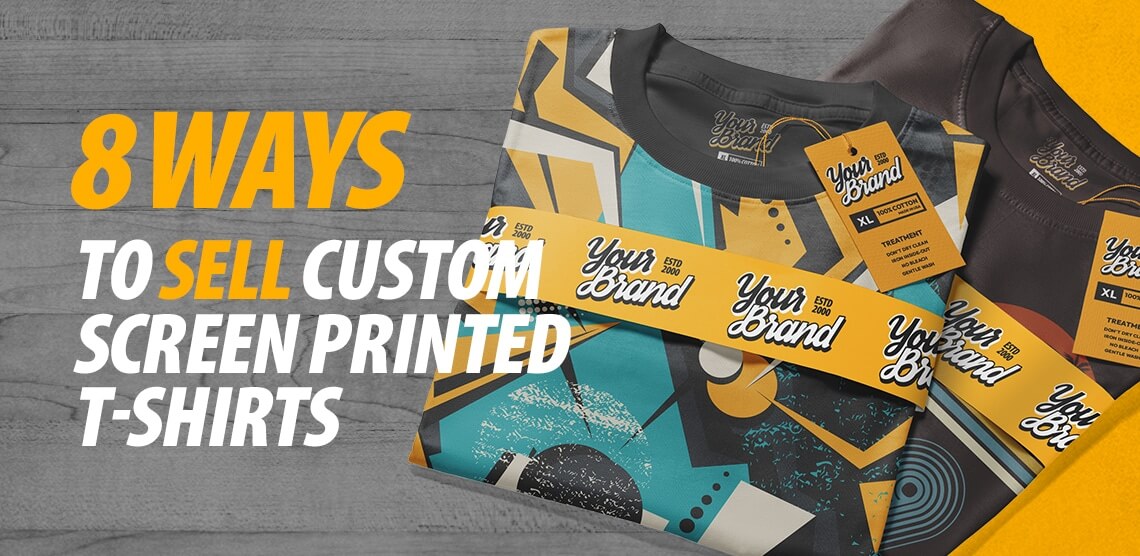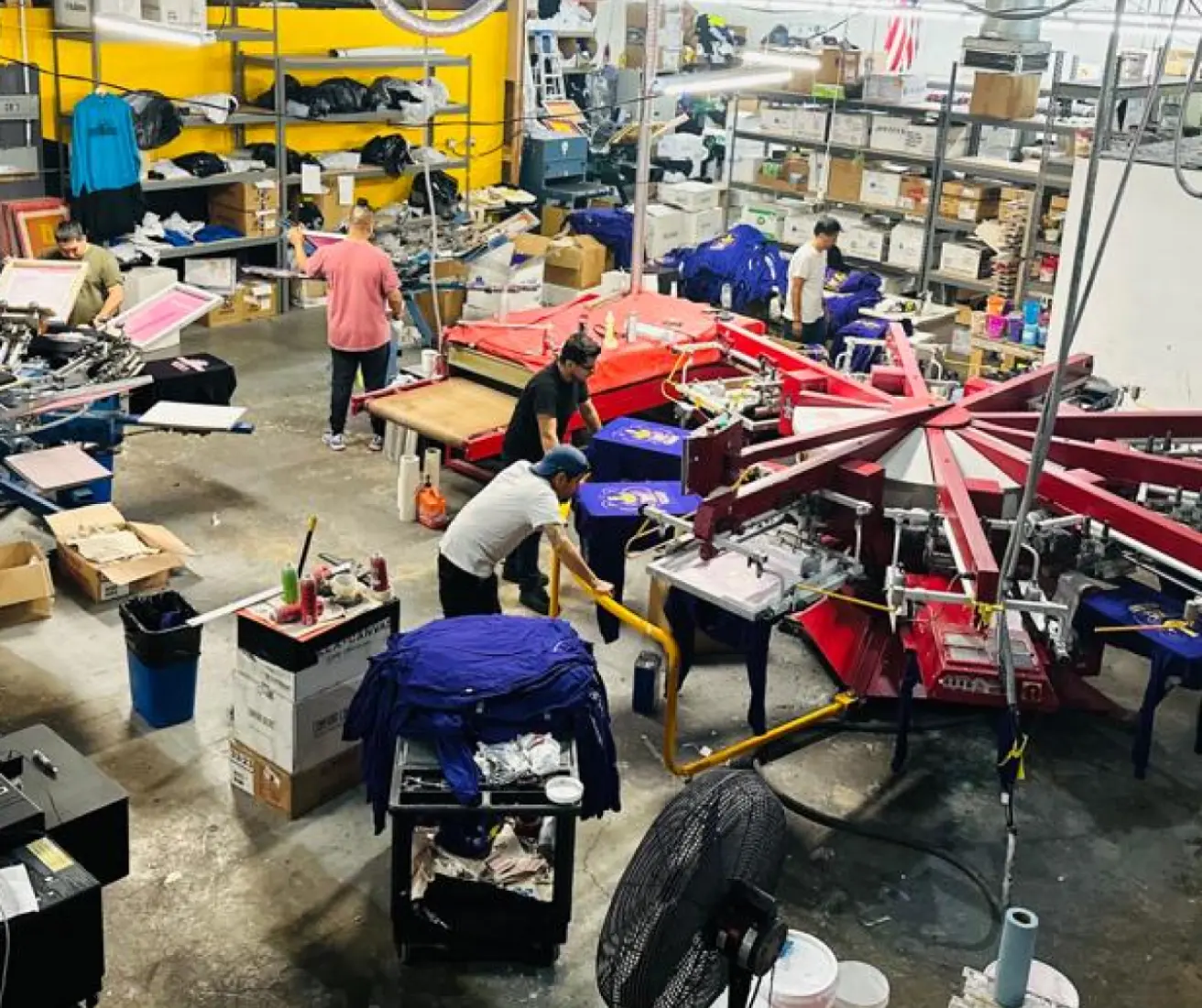Affordable Custom Screen Printing Services for Small Businesses
Wiki Article
Screen Printing Uncovered: Whatever You Required to Find Out About Tee Shirt and Garment Printing Techniques
If you have actually ever before wondered exactly how those lively designs wind up on your favored tee shirts, you're in the appropriate area. Display printing is a fascinating approach that incorporates art with method, using endless opportunities for imagination. Comprehending the principles, from equipment to ink selections, can significantly affect your results. All set to discover the crucial aspects that make display publishing an art type? Allow's uncover the information that can boost your tasks.
The Essentials of Screen Printing: Just How It Works
When you plunge right into display printing, you'll discover it's both a scientific research and an art. At its core, screen printing involves developing a pattern, or screen, that enables ink to pass through just in specific areas (screen printing kit). You begin by choosing your layout and preparing your display with a light-sensitive solution. As soon as you subject this emulsion to light, it hardens, leaving your style as a negative space.Setting the screen over the material, then use a squeegee to push ink through the display onto the garment. Each action is essential, and mastering them will elevate your display printing skills, changing basic garments right into one-of-a-kind, expressive pieces.
Kinds Of Display Printing Techniques
When you understand the fundamentals of display printing, it's time to check out the numerous methods that can boost your designs. One prominent technique is typical screen printing, where ink is pushed with a stenciled screen.If you're going for great information, take into consideration discharge printing. This technique eliminates dye from the material, leaving a soft, vintage appearance. Another option is plastisol printing, known for its durability and vibrant colors, making it a preferred for numerous brands. Experiment with halftone printing to create slope results and complex styles. Each strategy has its distinct beauty, so don't be reluctant to attempt them out to find what suits your style best!
Essential Devices for Screen Printing
To achieve sensational outcomes in screen printing, having the ideal devices is basic. You'll need a durable display printing framework, which holds the mesh that moves your style onto the garment. Next, invest in high-grade mops; these are necessary for applying ink equally across the display.Selecting the Right Inks and Materials
When selecting inks and products for screen printing, you require to take into consideration the type of ink that functions ideal for your job. Think about fabric compatibility to ensure your designs look last and wonderful long. Discover eco-friendly ink choices to make your printing process much more sustainable.Kinds Of Display Inks
Picking the best screen ink is essential for achieving lively, resilient prints that meet your project's requirements. There are numerous sorts of screen inks to examine. Plastisol ink is preferred for its adaptability and simplicity of use, offering excellent color opacity on dark textiles. Water-based ink, on the various other hand, provides a softer feel and is environment-friendly, making it suitable for those wanting to minimize their ecological influence. Discharge inks remove dye from the material, causing a soft, vintage appearance however require particular handling. Specialty inks, such as glow-in-the-dark or metal, can include distinct effects to your styles. Review your project needs and pick the ink that straightens finest with your preferred result.
Textile Compatibility Factors To Consider
Understanding textile compatibility is important for achieving premium screen prints, particularly considering that different products respond distinctly to different inks. When selecting inks, take into consideration the fabric kind-- cotton, polyester, or blends. For cotton, water-based inks function well, providing gentleness and breathability. Polyester, on the various other hand, often needs plastisol inks for far better adhesion and dynamic shades. If you're printing on blends, you may require to use a mix of both kinds. Constantly test your inks on example textile to assure they stick correctly and preserve shade honesty. Furthermore, remember that material weight and appearance can impact the final outcome, so choosing the appropriate ink and material combination is crucial for your job's success.Eco-Friendly Ink Options
Environmentally friendly inks are ending up being a popular choice for screen printers who desire to reduce their environmental influence while preserving quality. When selecting inks, take into consideration water-based inks, which are less dangerous and much easier to clean up compared to typical solvents.Additionally, search for inks made from renewable sources, such as soy or vegetable-based choices. By picking the appropriate inks and materials, you'll not just produce sensational designs but additionally contribute to an extra sustainable printing procedure. Make the switch, and your prints will show your dedication to the setting!
Preparing Your Layout for Screen Printing

File Layout Demands
To assure your layout looks sharp and vibrant on fabric, you'll need to pay attention to submit style needs for display printing. Begin with vector files like AI or EPS, as they can be scaled without losing high quality. If you utilize raster photos, select high-resolution data, such as TIFF or PNG, ideally at 300 DPI. Avoid making use of JPEGs, as they can shed clearness when resized. Make sure your layout has a clear history to avoid undesirable white sides on your prints. Keep shade modes in mind; CMYK is basic for screen printing, so transform your RGB creates appropriately - screen printing kit. By complying with these guidelines, you'll establish your art work up for an effective print.Color Splitting Up Strategies
Color separation is an essential action in preparing your layout for screen printing, and mastering it can greatly improve your print top quality. You'll require to damage your design into individual colors, as each color calls for a separate display throughout printing. Begin by identifying all the colors in your layout and produce layers each. You can make use of software like Adobe Photoshop or Illustrator to isolate and separate colors efficiently. Be particular to save each layer as a different data, usually in a style like TIFF or PSD. This precision not just ensures exact color representation however likewise streamlines the printing procedure. By taking notice of shade splitting up, you'll attain specialist and dynamic cause your screen-printed garments.Resolution and Size
Attaining the ideal results in screen printing begins with assuring your design has the right resolution and dimension. Preferably, your art work must go to least 300 DPI (dots per inch) for sharp, clear prints. If you make use of lower resolution, your last item might look less than professional and pixelated.When it pertains to size, think about the measurements of your print location. Style your artwork to match the final print size, ideally developing it in the actual dimensions you'll be publishing. By doing this, you'll avoid any unanticipated scaling problems.
Constantly examine your design in both vector and raster formats. Vector graphics can be scaled without losing top quality, making them suitable for display printing. Preparing properly will assure your layout looks incredible on every garment!
Step-by-Step Display Printing Refine
Screen printing is a dynamic process that allows you to produce lively layouts on different surface areas. To garment printing get started, you'll require a display, solution, and your selected ink.After washing out the unexposed emulsion, your display is prepared. Set it up on your printing surface and straighten your garment below it. Pour ink onto the display and make use of a squeegee to press the ink with the stencil onto the fabric. Raise the display meticulously and allow the print dry. Finally, cure the ink making use of warmth to ensure toughness. That's it! You've successfully display published your style.
Tips for Effective Display Printing Projects
While you're diving into your display printing jobs, keep in mind that prep work is key to success. Begin by gathering all your products-- inks, squeegees, screens, and garments. A clean office assists stop unwanted errors, so clean up prior to you begin.Following, verify your artwork is high-resolution and effectively sized for your garment. Check your screen for correct exposure and tidy it completely to stay clear of smudges. When blending your inks, follow the manufacturer's standards to attain the appropriate uniformity.
During printing, apply even pressure with your squeegee for constant results. Do not rush; take your time to confirm each print satisfies your standards. After printing, allow your garments dry entirely prior to handling or packaging them.
Lastly, constantly maintain an example of your job for future recommendation. In this manner, you can assess your progression and improve your strategies over time. Pleased printing!

Regularly Asked Concerns
How Lengthy Does It Take to Establish up a Screen Printing Work?
Setting up a screen printing work usually takes around thirty minutes to an hour. You'll prepare the displays, mix inks, and adjust journalism. The time differs based on intricacy and experience, so stay arranged!Can I Print on Various Fabric Types Utilizing the Very Same Strategy?
Yes, you can publish on various material types utilizing the very same method, but you'll require to adjust your settings and inks. Some fabrics absorb ink differently, so trying out warranties the very best outcomes for each product.What Are Common Errors to Stay Clear Of in Screen Printing?
When display printing, stay clear of usual mistakes like making use of the wrong ink, overlooking proper exposure times, or missing pre-press checks. Always evaluate your setup and keep tidy displays to ensure high quality outcomes each time.How Can I Correctly Tidy and Keep My Display Printing Tools?
To effectively tidy and maintain your display printing tools, you should frequently clean displays with appropriate solvents, examine mops for wear, and assure all tools are stored dust-free and dry. Uniformity enhances and prevents pricey fixings efficiency.Is Display Printing Ecologically Pleasant Compared to Various Other Approaches?
Display printing can be more eco-friendly than other techniques, particularly if you make use of eco-conscious products and water-based inks. By choosing sustainable materials and techniques, you minimize waste and decrease your influence on the world.Display Printing Uncovered: Whatever You Need to Know About T-Shirt and Garment Printing Methods
At its core, screen printing entails developing a stencil, or display, that permits ink to pass through just in certain areas. Position the display over the textile, then make use of a squeegee to press ink via the display onto the garment. One popular method is conventional screen printing, where ink is pushed through a stenciled display.When picking inks and products for display printing, you require to take into account the type of ink that works finest for your job.
Report this wiki page